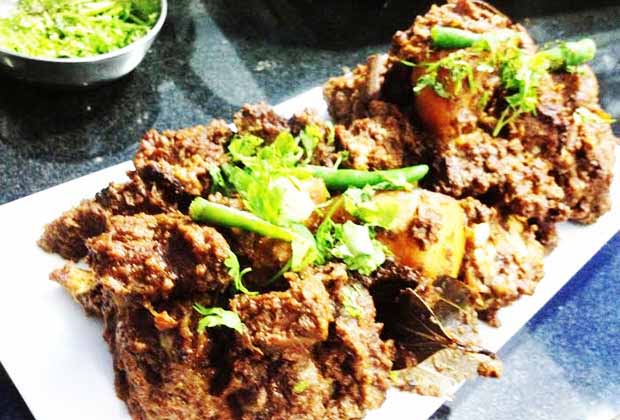Of new beginnings and Kosha Mangsho
- By Kalyan KarmakarLoading...
- | 28 April 2015 2:09 PM IST
 X
X

Poila Boisakh or the first day of the Bengali New Year may have gone, but the month of April is a happy month for us Bengalis.
Apart from wearing new clothes and having shopkeepers perform a puja to mark the opening of new accounting books or haal khaata onthe day, Poila Boisakh has always been centered around food. It is, after all, integral to all Bengali festivities.
Special days or even Sundays used to be mutton days for Bengali households at a time when meat wasn’t eaten regularly. I remember people queuing up outside small local mutton (goat meat) shops in the neighbourhood to buy meat when I was growing up.
This was before red meat became a bad word, thanks to the medical trade. Now chicken finds a bigger place in Bengali households.
Sundays used to be a day for Mangsher Jhol or mutton cooked in thin gravy with potatoes.
Kosha Mangsho is de rigeur on more special days like Poila Boishakh though. It is a slow-cooked mutton dish cooked in a thick onion and garam masala base.
This is the dish I cooked when we first began to entertain people at our home in Mumbai.
My recipe was based on what I had found on the Internet, and I used tomato, which is not traditionally used.
Since I often had non-Bengalis over, I didn’t really use mustard oil, which is the traditional Bengali oil of choice as some would find it too sharp. I later made the dish with mustard oil.
The biggest deviation from tradition in my recipe is the use of pressure cooker instead of slow cooking it.
I just found this a lot more practical in a fast-paced world. The resultant mutton would always be quite tender and the gravy base evenly spiced.
After I moved to Mumbai, I used to go to mutton shops at Pali Market in Bandra, then to a mutton shop called Modern Mutton and later to the mutton section at Khar Market.
Nowadays I call in for mutton from Meghna Agro at Bandra’s Pali Market in Mumbai and find it to be pretty good.
Here is my recipe for Kosha Mangsho. Try it out and make yourself a celebratory Bengali meal.
Ingredients: (Serves 2)
Cooking time: 40 minutes
500 g fresh mutton
1 tsp ghee/ vegetable oil (the authentic version would probably have 6 tbsp of mustard oil)
2 tsp of whole garam masala (cardamom, cinnamon, cloves) and bay leaves
4 - 5 split green chillies
2 potatoes cut into half
3 red onions ground to paste or finely chopped (the advantage of a paste is that you hardly need any oil to fry them then
Paste of 1 tomato (optional)
2 tbsp of ginger paste, 1 tbsp of garlic paste.
*A cardinal rule of Bengali cooking is that garlic is sparingly used. If you are using both, then ginger should be twice the amount of garlic. If you are not sure then only put ginger.
Mutton marinade paste:
1 tsp ketchup
3 tsp curd
2 tsp each of chilli powder, garam masala powder, jeera powder
1 tsp sugar
1/2 tsp haldi
I/2 teacup of water
1 tsp salt
Equipment:
Pressure pan/ cooker.
*I prefer this as it quickens the process as mutton takes a while to cook. You can make it in an open pan too.
Method:
1. Marinate the mutton in the marinade paste and keep it in the fridge for as long as possible. Even half an hour would help. The longer the better.
2. Put the pressure pan on the burner, switch on the flame, heat the oil in it and then saute the whole garam masala, green chillies and bay leaves in the heated ghee/ oil.
3. Once the spices crackle, add the onion paste. Keep stirring till the onions become brown and begin to stick to the vessel. This is VERY important and is key to a good kosha mangsho. Don’t hurry this step.
4. Add the ginger and garlic (2:1) pastes and stir the mixture till it begins to darken and stiffen.
5. Add the tomato pulp to the base and let the base cook till it looks dark brown.
6. Add the marinated mutton and potato, salt and stir the mixture together for about 5 minutes.
7. Add half a cup of water, shut the pressure cooker and put the stove on high flame. Wait for about 4 - 5 whistles, put the flame on simmer and let it cook for another 15 - 20 minutes.
6. The gravy base should be dry when you open the cooker. If not, just cook it on the open flame till it becomes dry.
7. Serve with luchis, parathas, rotis or the Bengali mishti pulao.
Here’s a link to my video on how to make Kosha Mangsho ->
Photo credit: Kalyan Karmakar
Kalyan is a Mumbai-based food blogger and columnist who loves to travel in search of local tastes. He is at his happiest when eating at small, family-run places. His blog Finely Chopped won the Best Food Blog Award in 2013 and 2014 at the Food Bloggers Association of India awards. He is the lead critic for Mumbai at EazyDiner and is a columnist for Femina. He is also the Chief Chowzter for Mumbai, and conducts food walks in the city.
Follow Kalyan on Twitter @finelychopped

Kalyan Karmakar
Kalyan is a food and travel blogger, who is excited about Indian food and tries his best to bring it alive through his stories. He is happiest when he eats at small, family-run places. He blogs at <a href="http://www.finelychopped.net/"> Finely Chopped.</a>


